|
|

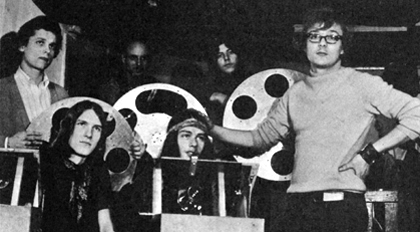
The Legendary TEZCATLIPOCA LIGHT SHOW of Denmark
A Short Story: 1968-1974
About a legendary Danish Psychedelic Light Group
By Mikkel Scharff - © January, 2004/August, 2006/March, 2012
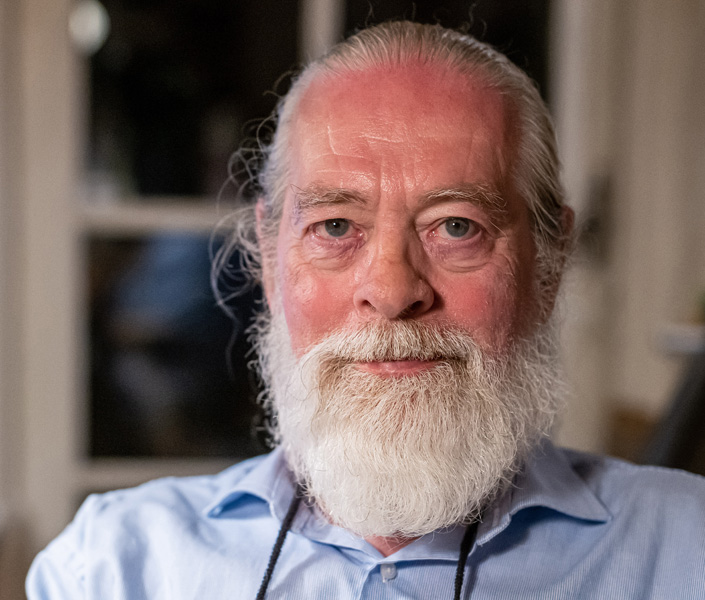
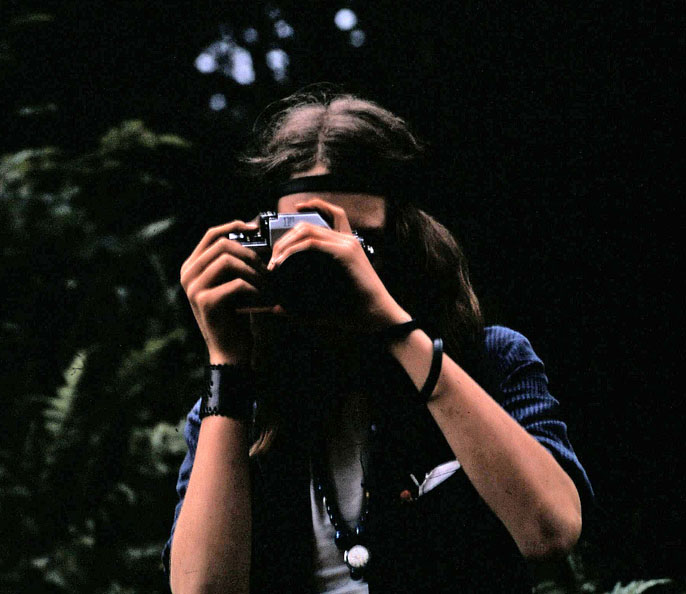
Left: Mikkel Scharff, early Spring, 2022, selfie. Right: Mikkel Scharff
with his magnificent Nikon F analogue film camera, ca. 1970.
This web page was edited and expanded with more historical photos,
old and new, as of May 12, 2023, by Torsten Olafsson:
"EPILOGUE - The Aftermath" added at the bottom of this web page.
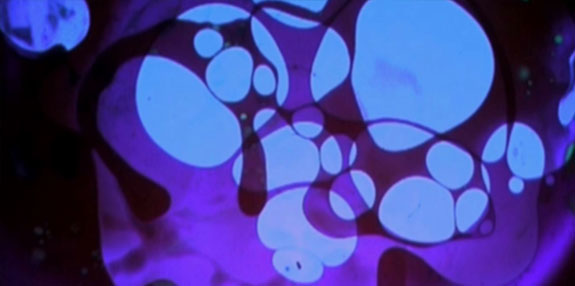
1 - Introducing Tezcatlipoca Lights
The very beginning of what was later to become Tezcatlipoca Lights originated from various events that took place during the fall of 1968 (as well as the chronicler remembers). Then, a little more than a year after, a somewhat provincial version the "Summer of Love" took place in Copenhagen, Denmark, with various local events in among others "Kongens Have" (The King's Garden in central Copenhagen) and "Langelinie" (a picturesque area in the harbour of Copenhagen).
The events included free-style jam sessions with the local hippies (dressed as such), wearing flowers, or open-air concerts with some of the first sub-culture bands. Such events were certainly - although we later learned, only remotely - mimicking what was learned about similar events in f.i. San Francisco, USA, or "Swinging London", UK - then some of the centres of what came to be known as hippie lifestyle and psychedelic music.
Obviously, it was rather limited what could be learned about the details of this new culture and music. Only few Danes had first-hand knowledge about these phenomena, actually rooted in the 1950s beatnic culture on the West coast of the US. Reports in the mainstream press and most other media were only worth a laugh.
But indirectly - or through more reliable sources - information could be gathered. A few alternative record-shops appeared, specializing in direct import of this new music and various paraphernalia (posters, imported alternative music magazines or hippie magazines, etc.). These imported LP-records were completely different to the types of records available in regular record shops, featuring groups and single artists at the same time as they could be read about in the alternative magazines.
A few Danish, alternative magazines also emerged - often linked to the alternative shops ("Superlove", e.g.). One way of getting to know this new culture was simply by studying the record covers, the illustrations or cover notes, and just by looking at record covers it was obvious that the new phenomenon - light show - was regularly used at concerts by these psychedelic groups and was part of the new culture. Just judging from the record covers, a light show appeared to be a very different way to create stage lights than previously seen! Apparently, one of the centres was San Francisco with its "Filmore Auditorium" and "Avalon Ballroom".
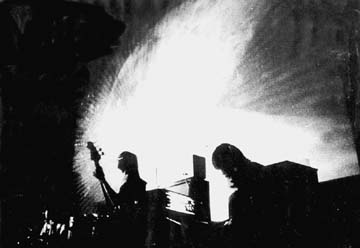
ACHE bathed in Texcatlipoca Light Show's intensely pulsating,
psychedelic light show.
Midnight session, The Dagmar Movie Theatre, Copenhagen, 1970.
During the fall of 1968 some of these bands came to Copenhagen to perform. Either at the established concert halls (due to "professional" promoters) or at some of the alternative - rather small - venues (clubs) that began to appear. Although it was - of course - expensive to get a band to Copenhagen from abroad, some actually began to arrive with their own light show, although in most cases the expenses of including the foreign band's light show was "spared".
One example is Pink Floyd who performed with their own light show sometime during the fall of 1968. In a - now to be considered - fairly small joint with probably around 100-200 seats. The chronicler found the light show to be breathtaking - performed by one person, with a few pieces of equipment and ending up with a flash of fireworks!
During the same period - fall 1968, spring 1969 - an increasing number of US bands appeared in Copenhagen, featuring a light show, e.g. Jefferson Airplane. Most of us with interest in light show (and the music, of course) went to these gigs for inspiration.
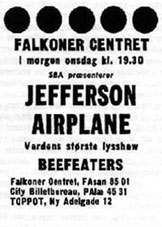
Without any doubt there was a vast difference between our ambitions (when we saw the foreign - US - light shows) and the Danish reality. Apparently, in the US the light shows had another economic base, judging from their equipment and number of staff - a level we would certainly never be able to reach. Perhaps a bit astonishing to us, taking into account that the visiting bands and light shows came from the "alternative" sector of the music scene. However, we quickly learned (were forced to realize ...) that most effects could be reproduced or developed with much simpler - and cheaper - equipment. In some cases, even, the chronicler would claim that the alternative equipment was at least on level with - if not better - than the fancy US equipment.
While none of the Danish light shows might have invented or developed groundbreaking new types of equipment or techniques that had not been seen previously in various forms, the equipment, the techniques and the form in general - however - did develop into something quite different and distinct from the (US) light shows that was the original point of inspiration.
Needless to say, politics (local and world) played an important role at the time. A time of major changes, of youth revolution, of the Vietnam war, new political parties. However, although quite a lot of the music (and the whole "scene") at the time was political in one or another way, in this context the importance of politics will not be further developed.
2 - Klub 27: A Psychedelic Art Melting Pot
Hippies and other young persons with an "alternative" bend found places to meet during 1968, such as "Galleri 101" and "Klub 27", where they could "turn on, tune in, take over" and where the new music was performed. "Underground" clubs they were called, and Klub 27 was one such place. The name originated from the site of the club, a worn-down abandoned two-story industrial building in "Masnedøgade" 27 (the building was later replaced by ordinary tenant buildings).
The first floor of the L-shaped industrial building was the site of the club. Two rather big rooms made up the premises, one lounge-like room where members could gather, have something to eat and drink (only vegetarian, organically grown food and non-alcoholic drinks were served), and another room with a low bandstand where the bands performed. The audience would sit around on the floor or on abandoned wooden beer bottle boxes enjoying the music - only a few dancing. Bands usually played/performed "on the door", i.e. their wages were a percentage of the entrance fees. Thus, the earning was proportional to the number of visitors they could attract.
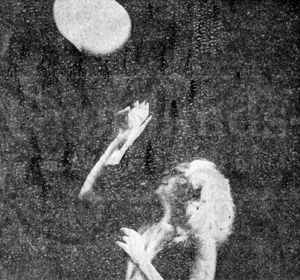
Fureflip happening at Klub 27 in Copenhagen, 1969
In "Klub 27" Tezcatlipoca Lights was formed. The chronicler began to visit the club regularly during the fall of 1968 shortly after it was formed. A few times a guy, whose name the chronicler unfortunately only remember as Elo, performed a fairly simple light show with one slide projector and "wet slides" (to be explained - see section 13 below). The chronicler's interest in light shows grew and after a while he tried himself using a borrowed slide projector. This was the beginning. Elo was very helpful, and during 1969 he developed some electronic means of regulating light levels and various motors.
While the chronicler soon had his own, regular light shows in the club with whoever was playing, other regular members of the club likewise became interested in the light show and soon joined the light show group, investing in their own equipment or - when the light group became more stable - equipment was bought with money earned. That is: gradually, the light group began to get a share of the income at the door to cover costs (and in order to invest in improvements). During spring or summer 1969 the light group was a reality, a name - Tezcatlipoca - was devised and the group began to tour with various bands outside the Klub 27, parallel with regular light shows still being performed at Klub 27.
3 - The Name "Tezcatlipoca"
The name is that of an Aztec god!
As was the case for rock (or "beat") groups at the time of forming the light group, the group was on the lookout for an uncommon name. Naming convention for rock groups changed during the 1960s, the tendency being to "turn on, tune in" and try to find a name that signalled "psychedelic" or perhaps a commonly used word. Such common words, used as a name for rock groups were considered daring and up-front.
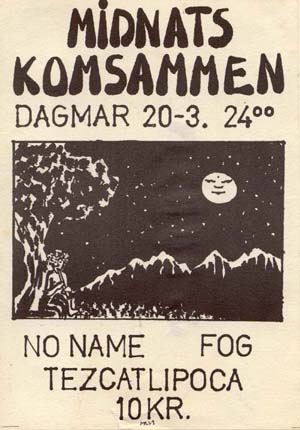
The light group went through many considerations until it was decided to use the name of the Aztec "great Sky God" (Vaillant, G.C. "The Aztecs of Mexico, 1944, Penguin Books, reprint 1960, p. 69 - the book in which we read about the name). It was considered to be rather exotic and fairly original. In daily use the group used just "Tezcatlipoca" - refraining the use of the full name for more formal presentations such as concert posters. In hindsight the choice of an Aztec god as the "exotic" source of a name probably tells more about our limited world view - and perhaps a lack of understanding the Aztec culture …
Numerous other names were being considered, among which apparent was "The Prince Valiant Barbershop". As history shows this was eventually abandoned.
4 - The Tezcatlipoca Lights' Members
Mikkel Scharff (the chronicler): wet & colour slides, switch boards
Lars Christensen: wet slides, overhead
Frank Hindsberg: wet slides, overhead
Bjørn "Mulle" Jacobsen: wet slides
Bent "Dyt" Holm: wet slides
Rikke: wet slides
Gitte: wet slides
5 - Other Light Groups
Danish, Copenhagen: Lysholmortensen - Camelius Mørks Dynamostråle
- King Kong - Søren Danielsen - and more.
Foreign, performing in Copenhagen, Denmark: The Electric Light Circus, 1969 - Pink Floyd light show, 1968 - Jefferson Airplane, 1969 - and more.
6 - The Association "Musik og Lys"
"Musik og lys" (Music and Light) was an association established in early 1970. As stated in the association's first publication it was formed by approx. 50 bands and light show groups (including Tezcatlipoca) in order to bring the action into the hands of the bands/light groups - away from various businessmen, promotors and bookers that usually took a heavy share of the income gained at gigs.
The association published a yearly promotional publication with a one-page introduction to each band and light show group, had a price-sheet for all members and produced quite a number of smaller and larger gigs in the beginning of the 1970s. Venues ranged from smaller clubs to concert halls as well as e.g. a regular event called "Midnight at Dagmar", where one or two bands and a light show did a gig from midnight and onwards in the Copenhagen cinema "Dagmar" after the evening film ended. Income was shared democratically, i.e. evenly, between the total number of performers, bands and light show groups alike.
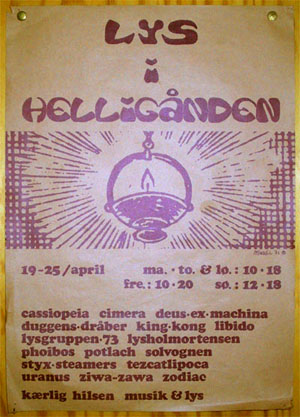
One interesting event was a three-day gig at a place named "Helligåndskirken" (Church of the Holy Spirit) where all the light shows being members of the association made a presentation of their individual shows and techniques. During this event the bands - that were usually the main reason for gigs - were reduced to acting as support for the light shows.
7 - Tezcatlipoca and the Bands: Ache & Hurdy Gurdy
Early regular collaboration with Hurdy Gurdy and Ache.
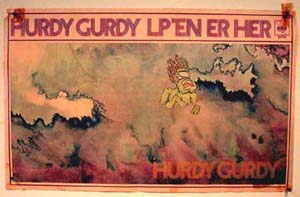
The collaboration between Tezcatlipoca and Hurdy Gurdy - known for their long improvisations - was partly due to the fact that Hurdy Gurdy fairly often performed in Klub 27. Thus, Tezcatlipoca and Hurdy Gurdy got to know each other's music and light effects more or less by heart. The result was in some cases a close and even somewhat intimate common performance where the light show staff - as perhaps expected - acted upon the basic feeling/mood of the music as well as on its minute details while the musicians - at least guitarist and bass-player - sometimes appeared to play to the light show with their back to the public and facing the screen with the light show effects. Since light shows in many cases was an art of improvisation, Tezcatlipoca and Hurdy Gurdy went on quite well on these common grounds of improvisation.
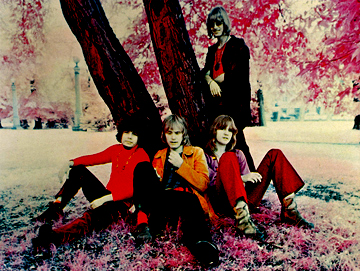
The collaboration with Ache was of another kind. Although Tezcatlipoca might not have had as many gigs with Ache in Klub 27, the common gigs there were somewhat more structured, since the music Ache performed was based on proper compositions and played as such even though parts of most "tracks" - as is was the rule at that time - dwelled into long and sometimes winding improvisations. During these improvisations some band members also played to the light show with their back to the public.
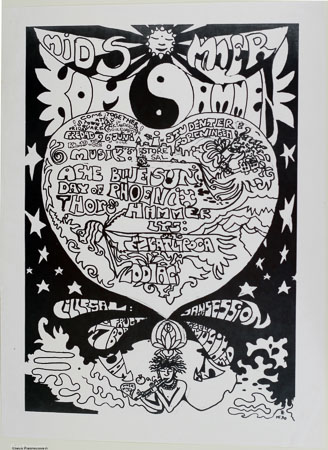
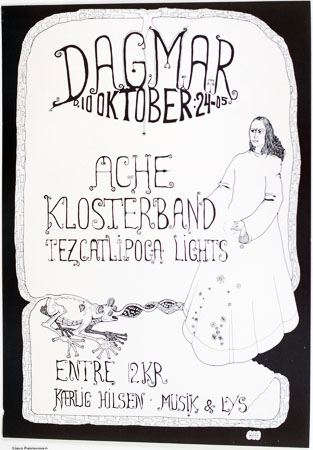
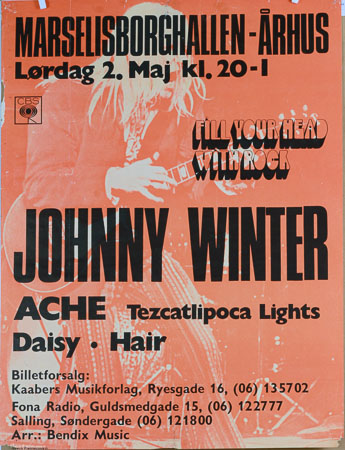
Rock concert posters, 1970: Tezcatlica presented their formidable artistically creative "psychedelic" light performances with symphonic, prog rock band ACHE
at the venues Studenterforeningen, "The Copenhagen University Students Association" center, and Dagmar Bio, C. Copenhagen, and with Johnny Winter Band in Århus, Denmark's second largest city in Jutland, W. Denmark.
Recently discovered original poster designs added on May 7, 2023, by Torsten Olafsson.
More irregular collaboration with other bands, single jobs:
Alrune Rod - Hey Joes Ballonrute - Hutlihut - Young Flowers - No Name - Gasolin' - Fog - Furekåben - and many more.
Later collaboration with: Masaladosa.
In fact, the list above ought to be much more inclusive - the bands mentioned are just a handful of bands being mentioned in the Tezcatlipoca "archives". Apart from the various bands performing in Klub 27 with Tezcatlipoca, the light group performed a number of single jobs (see below) with a number of bands over the active years of the Tezcatlipoca's existence.
Obviously, Tezcatlipoca met some bands regularly at various venues - e.g. No Name and Alrune Rod - and the collaboration with these bands range somewhere between the more established collaboration with Ache/Hurdy Gurdy and the once-and-only gigs with others.
8 - Tezcatlipoca and the Ache Rock Ballets
Tezcatlipoca and Ache soon began to work together also outside of Klub 27, and created together the music and light show for the two ballets "De Homine Urbano" (the world's very first genuine rock ballet) and "Little Things".
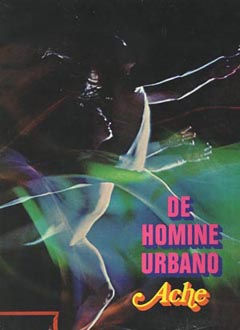
The music for these dance shows was taped and played back at the ballet theatres and thus completely structured and possible to follow by the ballet dancers as well as by Tezcatlipoca who performed live during the performances. For this reason the light show progress and effects were minutely designed down to each bar in the music score. On the image below an example is shown of the development of the light "score" for De Homine Urbano, staged at The Royal Theatre, New Stage, in Copenhagen in 1970.
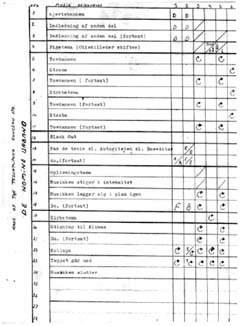
Perhaps another reason for the fruitful collaboration between Tezcatlipoca and Ache was the fact that Finn, Torsten and Mikkel knew each other very well from as early as primary school, Finn and Mikkel having been class-mates since the first grade, in 1959. The three have been involved in each other's projects for many years, and the collaboration in music and light was just another of their many projects. As can be seen on the (Danish) band pages, the collaboration between the three has continued long after Tezcatlipoca stopped.
9 - Venues
Klub 27 (at three locations over a span of a few years:
Masnedøgade, Blegdamsvej and Ryesgade - all in Central Copenhagen)
Studenterforeningen (The Student's Association, location:
H.C. Andersens Boulevard, Central Copenhagen)
Det Kongelige Teater (The Royal Theatre, Central Copenhagen)
Det Ny Teater (The New Theatre, Central Copenhagen)
Falkonercentret (Central Copenhagen)
Helsingør Teater (Elsinore Theatre in Elsinore, north of Copenhagen)
Brøndby Poppen (Brøndby in western Copenhagen)
Gladsaxe Beatforum (Gladsaxe in northern Copenhagen)
Huset, Tatuba (Central Copenhagen)
Munkekælderen (Central Copenhagen)
Dagmar Cinema (Central Copenhagen)
Boom In (Central Copenhagen)
Klub 47 (police youth club in southern Copenhagen)
Hedegården Youth Club
Roskilde Festival (Roskilde west of Copenhagen)
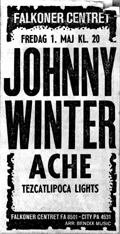
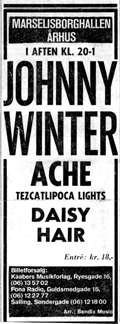
Falkonércentret & Marselisborghallen
May 1st & May 2nd 1970, resp.
Various public schools:
Holmegårdsskolen, Dragør skole, Sønderkærskolen and Egegårdsskolen, all in Copenhagen suburbs
Jylland (Jutland, the western peninsula of Denmark): Marselisborghallen (Aarhus)
... and many more.
10 - Economy
At the height of the integrated music and light performances the groups and the light shows were usually booked together for an entire evening (four sets). Sometimes the light shows received the same salary as the groups, more often they performed for a reduced salary. The latter was, perhaps, quite reasonable since the write-off on the balance sheet was usually much lower for light shows with a rather primitive and less expensive equipment than the write-off for musicians with their hefty wall-to-wall equipment and expensive instruments. Later, the venues (clubs, and the like) found it increasingly "difficult" to fund bands and light shows together and at the time when the present chronicler left the business in 1972-1973 it was becoming fairly rare to have a light show performing with a band, and the bands had cut down to three or even two sets.
An account sheet in the archives concerning Tezcatlipoca jobs from the end of 1970 - from November 1969 (about the time when Tezcatlipoca had their final jobs at Klub 27) to the end of 1970 - lists 21 jobs. Among the jobs were six times "De Homine Urbano" (the ballet at The Royal Theatre) and eight times "Little Things" (the ballet at The New Theatre). The remaining jobs were apparently scattered single jobs with among others the following bands: Hutlihut, Ache (support at Johnny Winter concerts), Kais Kamping, and Gasolin'. These jobs provided a total income of DKK 9260. The same account sheet lists investments in equipment at about DKK 8200. Since the remaining approx. DKK 1000 had to cover the running costs of materials (glass slides, oil colors, inks, bulbs) as well as transport, it remains obvious that not much was left to the usual five-six light show operators.
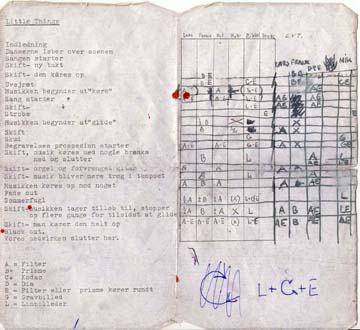
Needless to say, and with a somewhat distant view towards the Tezcatlipoca years, the light shows were something that we did primarily for the fun of it - not for the money!
However, an association such as "Musik og Lys" seriously tried to make things better in terms of salaries. The remedy was - among others - to cut away any surplus (or income) taken by the bookers/promotors and venues that arranged the concerts. By arranging the concerts ourselves, bands and light shows could obtain a better salary. Fully in accordance with this policy and with the spirit of the time, the association "Musik og Lys" published their (our) own price-sheet, listing DKK 5-600 in Copenhagen for light shows, bands asking the same, and up to DKK 2000 at far-away venues. To be honest, it was not often that it proved possible to obtain the listed price at outside venues, but at some of the jobs arranged by "Musik og Lys" we - bands and light shows alike - obtained an even better salary than the listed price.
11 - Rehearsal Facilities - Development & Maintenance
In Klub 27, Copenhagen
In workshop/studio in Absalonsgade 39A, Copenhagen
At home (and sometimes at work … )
Quite a lot of spare time went into cleaning, maintaining, developing and building new equipment, tools or effects, rebuilding, and making experiments. At the beginning it was done partly at Klub 27, at home (or sometimes at work … ). Later we tried to set up something more "professional", like the studios where the bands rehearsed. This was in particular the case when we planned, designed and rehearsed for the two ballets, and at that time we established a combined workshop and rehearsal studio in Absalonsgade, Copenhagen.
12 - Technique: Equipment
4 x Aldus Tudor 24 x 36 ("wet" slides)
2 x Noris 6 x 6 (vertically mounted, as overhead projectors)
4 x Braun D46 24 x 36 (colour slides)
1 x Kodak karrusel 24 x 36 (colour slides)
1 x Strobe with 1000 W bulb
3 x 500 W stage lights
4 x switch boards (electrical - partly electronic - for the control of all equipment)
Furthermore an abundance of small motors running color wheels, special effect wheels, prisms, and still more.
For the regular performances at "Klub 27" we build two "towers" of wood on which equipment could be placed above the heads of the public sitting, standing and sometimes dancing on the floor between the light show at the back of the room and the bandstand.
13 - Technique: Materials
Colored liquids used for "wet slides" were basically aqueous or oil-based. The main type of oil used were rhicinus oil, mixed with a variety of colorants such as methylene blue, "Organol" yellow and blue, as well as others to form all the basic colors (black, red, blue, green, yellow). Various off-the-shelf inks (brand "Pelikan") were used as the aqueous, colored component of wet slides.
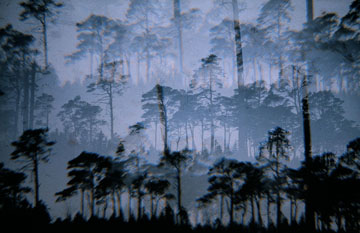
A large number of color slides, photographed with the purpose of being used in the light show, were used in the four slide projectors. Slides were usually in series of two or four, making it possible to "paint" the entire background (behind wet slides or overhead projections) with a continuous subject, a landscape for example.
Furthermore, a number of slides were produced by copying graphic materials - e.g. geometric patterns or black-and-white old prints. By means of the switchboard, all slide projectors or only two by two could be made to change at the same time, or dimmed in or out.
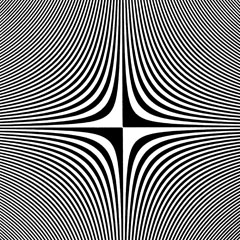
Wet slides to be used in ordinary, manually operated - today considered very old-fashioned - slide projectors were used intensively. Wet slides were made by means of five by five cm (2" by 2") slide glasses (used before modern plastic - or cardboard - slide frames became commonplace). One glass was laid on a table, e.g. an outer ring of oil-based color was applied (sometimes with a smaller ring near the center of the glass), and an aqueous ink in another color was put in between. Yet a piece of glass was put on top of the liquid colors and the "wet slide" was immediately transferred to the slide projector.
Care was taken that the new slide was dimmed in (and later out). Since the protective glass filter (lead glass) had been removed from the slide projector the aqueous ink in the "wet slide" quickly began to boil, creating white bubbles, well known in light shows. However, since white bubbles were not very nice in the otherwise colored appearance of the light show, usually colored filters were mounted (in "wheels") in front of each projector. These wheels could also be made to rotate slowly or quickly, i.e. synchronized with the beat of the music. A variation was to make a double-sandwich "wet slide": Three pieces of glass with two layers of colored liquid. In these, bubbles formed independently in the two layers, creating a more "complicated" pattern of bubbles.
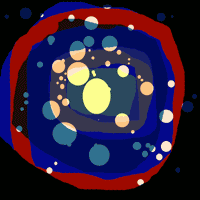
Another variation that I believe I learned from another light show performer (a "lysmand", i.e. "light man" as was then the common term!) named Søren Danielsen consisted of adding to the aqueous phase of a "wet slide" a few drops of a household glue (brand "Dana Lim"). This particular glue - when heated in the slide projector - then began to emit minute bubbles in the ink, bubbles not unlike the minute bubbles that stems from dishwasher soaps when in use in the kitchen sink! Quite spectacular - thanks again for the advice, Søren!
The development of bubbles and the speed of the development was closely related to guiding a proper amount of heat towards and away from the wet slide. The Aldus slide projectors had - like most other slide projectors - two ways of avoiding excess heat reaching the slide during normal use: A filter made of lead glass between the slide and the bulb and a fan streaming cold air past the slide.
In our case - wanting to make deliberate use of controlled amounts of heat - we had removed the lead glass from all projectors. To control the amount of heat reaching the "wet slide" we deliberately blocked the air stream when we needed heat to propagate bubbles and opened up the air stream again when we wanted to slow down the development of bubbles.
The Noris projectors were rebuild to be used as overhead projectors. Frank and Lars did a marvellous job with these projectors, mounting them vertically in a box (i.e., the lenses facing upwards), using a 45 degree-mounted mirror to project the images towards the screen behind the musicians. The level of the slides were completely rebuild to hold two small watch glasses between which the colored liquids were manipulated by Frank and Lars during the performances.
Apart from this basic way of operating the projectors, they were equipped with numerous effects like small color wheels, prisms and much more. Since both hands were necessary for the continuous manipulation of the watch glasses all controls (light level, speed of various motors) were build into a foot pedal. The quality of their homemade overhead projectors definitely surpassed the commercially available overhead projectors.
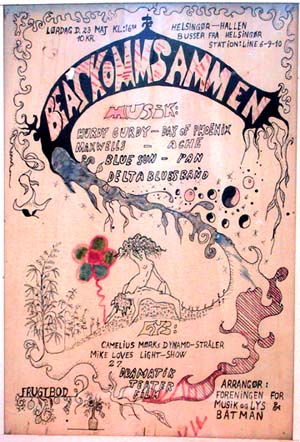
14 - Elements for More Vivid Light Shows
The general build-up and control of the various elements mentioned to accompany a piece of music consisted of a mixture of dimming in elements, one by one, adding layers to already existing layers. Sometimes - when an abrupt shift in the music were known or anticipated a number of elements or effects could be shifted at exactly the same time, some could be removed or added and the overall color "tone" could be changed. E.g. from a predominantly warm reddish appearance to a blue appearance. Thus, trying to underline the general feeling of the music. At lyric parts of the music the elements could be simple and soft, at heavy or quick parts of the music the effects could be sharp and quickly rotating color wheels could underline a tense feeling in the music.
In short, a light show consisted of a combination of less or more layers or effects, of the general color impression, and stand-still or rotation of colored filters, prisms and other effects. To this could be added traditional slides with motifs related to the music theme or the mood of the music, as well as other effects such as stroboscopes or ordinary stage-lights.
And of course - not least - a bunch of young dedicated people having a lot of fun when performing their very best with The Tezcatlipoca Light Show of Denmark!
Mikkel Scharff
Copyright © 2004 & 2006
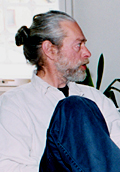 Mikkel Scharff in Olafssongs Studio, 2003
Mikkel Scharff in Olafssongs Studio, 2003
EPILOGUE - The AFTERMATH
By Torsten Olafsson, May 11, 2023
So, what happened then, over the past 50 years, or so ... ?
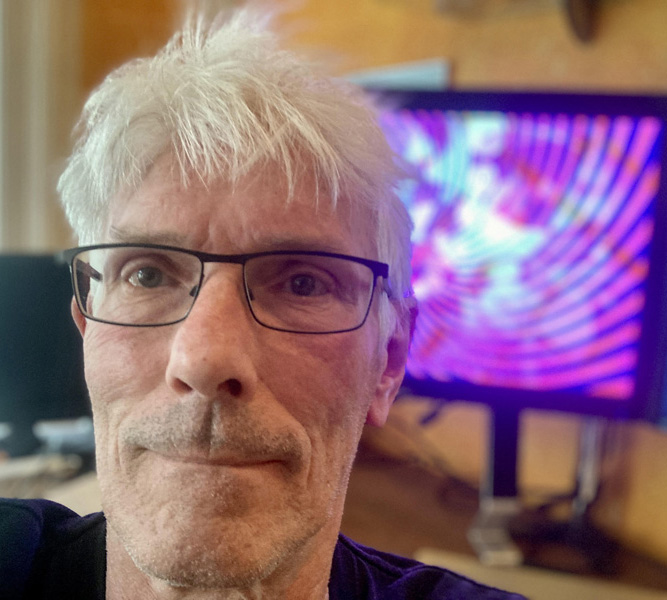

Frank Hindsberg, left, has continued ever since the 1970s as a creative and innovating professional stage and "psychedelic" lights designer and artist.
Mikkel Scharff, right, entered the field of art conservation, specializing in high-tech colour pigment analysis, research and teaching, as well as pictorial art and antiques colour layer restoration and re-creation.
Photos: Selfies
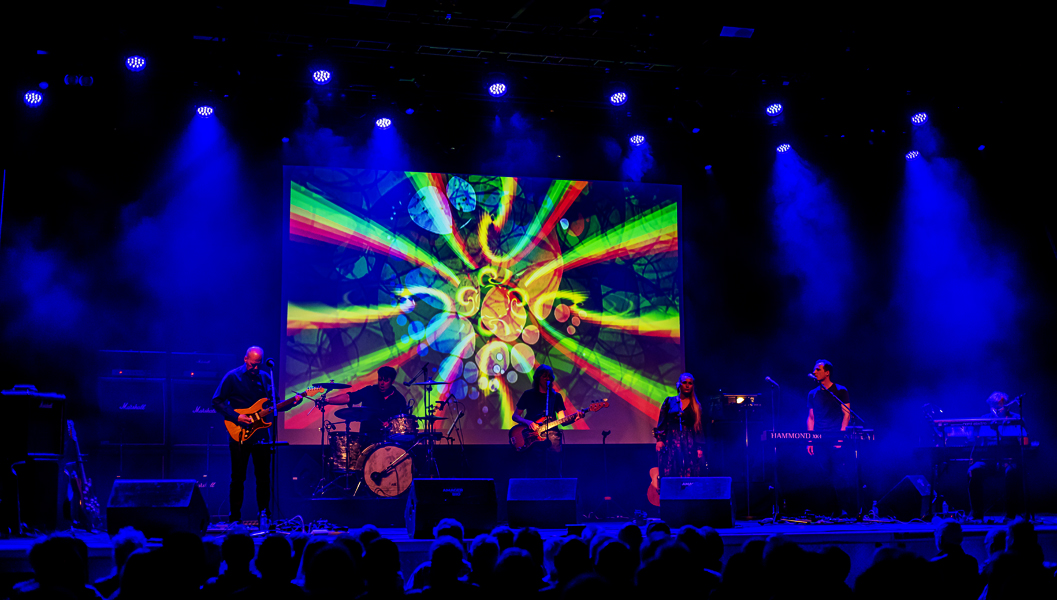
ACHE live on the Amager Bio stage on May 21, 2022. Digital psychedelic lights by Frank Hindsberg, assisted by Mikkel Scharff and René Gjerlřv.
Photo: Mikkel Scharff
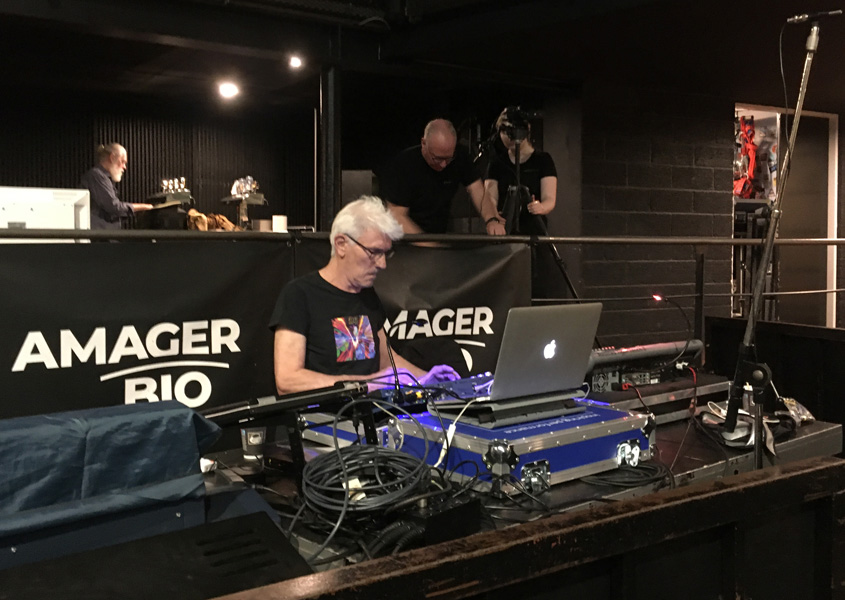
Frank Hindsberg with his digital psychedelic lights show control equipment, preparing for the ACHE 2022 rock band concert at the Amager Bio venue on May 21, 2022.
Photo: Torsten Olafsson
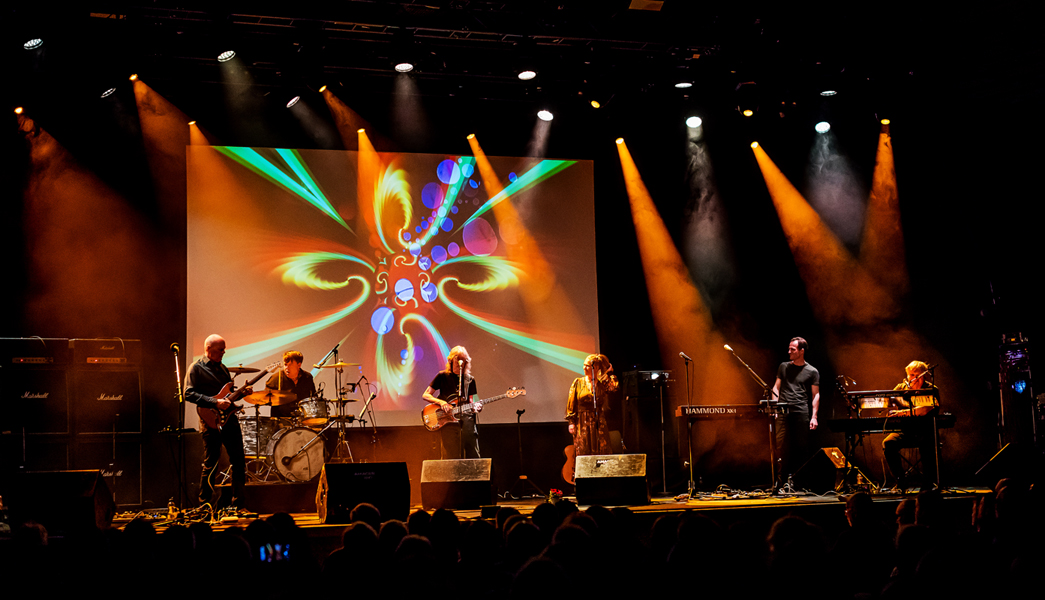
ACHE live on the Amager Bio stage on May 21, 2022. Digital psychedelic lights by Frank Hindsberg.
Photo: Mikkel Scharff
THE ACHE ROCK BAND OFFICIAL WEBSITE - DENMARK
c/o Olafssongs, Pårupvej 44, DK-3230 Græsted, Denmark
Copyright © ACHE c/o Olafssongs, Denmark.
|
WWW.ACHESITE.DK
|
|
























 Mikkel Scharff in Olafssongs Studio, 2003
Mikkel Scharff in Olafssongs Studio, 2003



